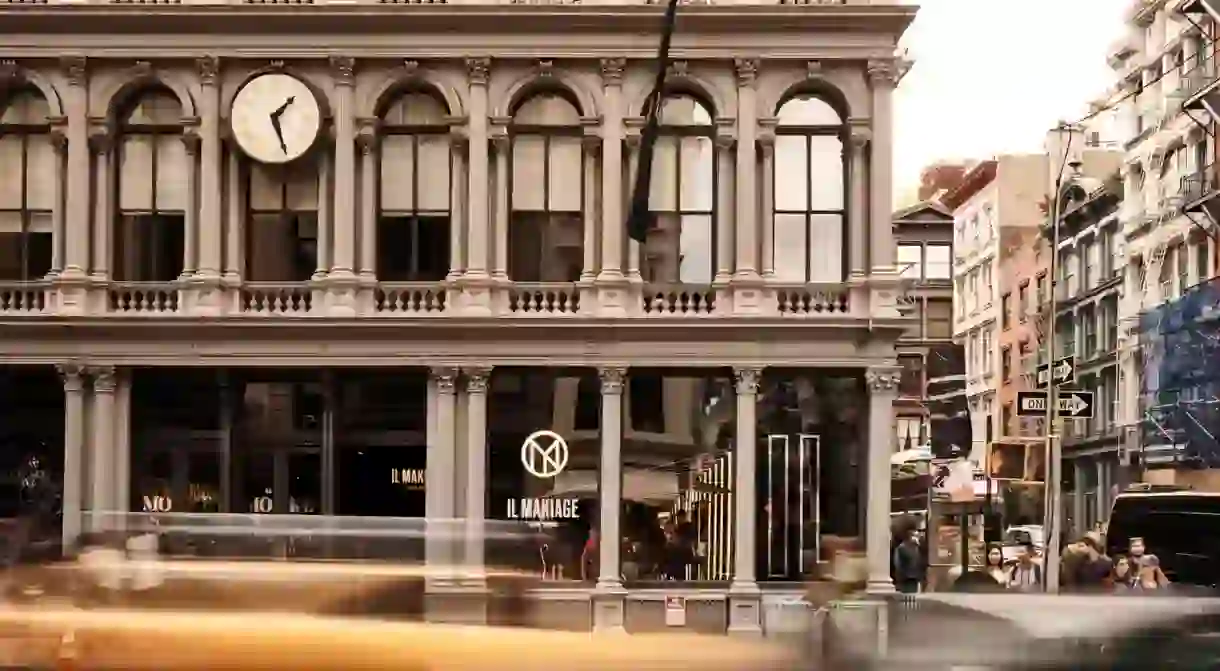The Most Iconic Landmarks in SoHo, New York

These eight landmarks – from subway stations to seminal stores – are a testament to SoHo’s fascinating past and iconic present.

SoHo isn’t merely defined by the way it is today – home to some of the world’s best shopping, dining, architecture and cobblestone streets. The neighborhood, which gets its name from its location south of Houston Street, was once an artists’ enclave: painters, writers and dancers moved into the abandoned warehouses and lofts found in cast-iron buildings in the 1970s as a cheap space to both live and work. While those artists have since vanished due to rising rents and a changing landscape, bits and pieces of New York City’s old-world history still remain at these iconic landmarks.
Fanelli Café
Pub, Bar, Cafe, Restaurant, Pub Grub

Long before SoHo morphed into the bustling shopping, art and culinary destination it is today, there was Fanelli Café, a teeny, dark, tin-stamped-ceiling bar on the corner of Prince and Mercer Streets. The second-oldest restaurant/bar in the city, Fanelli Café has had a slew of iterations since it opened in 1847: grocery store, saloon, Prohibition speakeasy, tavern, and now restaurant and bar. But what has remained the same for over 150 years is Fanelli Café’s role as a gathering place for the community. All of the artists who were working in SoHo at the time were constantly inspired by the conversations they had with other creatives or chefs or locals over a pitcher of beer at Fanelli’s. These days, the artists may have been replaced by chain stores, but the clientele largely remains the same: long-standing locals bellying up to the bar for a drink and stimulating conversation.
Housing Works Bookstore Café
Bookstore, Store

Rebecca Kelly Ballet
Theater

Rebecca Kelly Ballet was founded in 1979 during SoHo’s artistic peak. Kelly quickly joined the ranks of other dancers, painters and musicians who were moving to a dilapidated, quiet SoHo, filling the empty, affordable lofts with all kinds of art. These days, Rebecca Kelly Ballet has morphed from a single studio in SoHo into a touring contemporary ballet company that spends summers in the Adirondacks. The dances are often topical or provide social commentary, blending traditional ballet forms with modern shapes. Rehearsals still take place in the original SoHo loft (passersby often spot dancers gliding through the space above Broadway), and tickets can also be reserved to see performances at the studio.
Artists and Fleas SoHo
Shop

Housed in an expansive, loft-style room, Artists and Fleas is a marketplace for locally made products. Over 30 sellers occupy the space, each with their own stall, hawking home-made goods such as hand-hammered pendants, quirky earrings and framed illustrations. Plus, there are frequent pop-ups hosted in the back, along with discounted piercings and tattoos. Although the SoHo location has only been around for a short time, it pays homage to the artists who once worked in the neighborhood’s lofts and shaped the area into the creative hub it is today.
Kenn’s Broome Street Bar
Bar, American
In SoHo’s sea of designer stores and upscale coffee shops, there are few places as storied old world as Kenn’s Broome Street Bar. Since 1972 (it’s housed in a landmarked building dating back to 1825), the no-frills bar has been frequented by locals in search of draft beers, comforting pub fare (like burgers slipped into pita bread) and friendly conversation. The bar feels like a neighborhood pub straight out of London, replete with dusty wooden floors, stained-glass panels (from the late 19th century when the space was a German beer hall) and golden lion heads that hang from a green sign outside. Before his death in 2014, then-owner Kenn Reisdorff was adamant about making his bar a welcoming space for the neighborhood’s ever-growing artist community. But even as SoHo changed and the artists vanished, Kenn’s Broome Street Bar has remained.
The Apple Store
Store

From the 1920s until the early 2000s, a post office occupied the corner of Greene and Prince Streets. The squat, tan-brick building was often the subject of complaints from SoHo residents, who grumbled about long wait times and surly employees. Apple took over the building and opened its first New York City retail location in 2002, keeping its early-20th-century exterior (which still flaunts ‘Station A’ and ‘New York States Post Office’ on the outside) while upgrading the inside with the technology company’s sleek designs. It’s a bit of old-world New York on street level, harboring the future of tech inside.
MoMa Design Store
Museum, Shop, Store
Canal Street subway
Train Station

The Canal Street subway, built in 1917, is at the junction of Chinatown and SoHo, where the 6, N, Q, R, W, J and Z trains converge in one station. Its many connecting hallways are filled with string instrumentalists knitting together classical music sonatas and poets quickly tapping out haikus on typewriters. The mornings and evenings are rife with commuters carrying briefcases and locals shepherding carts of fruit and groceries up and down the stairs. But no matter the time or day, the many exits thrust you into the bustle and chaos of Canal Street – from the street peddlers selling knock-off Chanel purses to the outdoor fish market offering everything from tiny shrimp to octopus.

Our debut short film, The Soul of Soho, explores neighborhoods separated by oceans, history and culture but united by craft community and change. Neighborhoods bound by one name: Soho. Intimate portraits of city living in the Sohos of London, New York and Hong Kong reveal rich stories of the people who bring life to these iconic neighborhoods. Explore Soho here.













